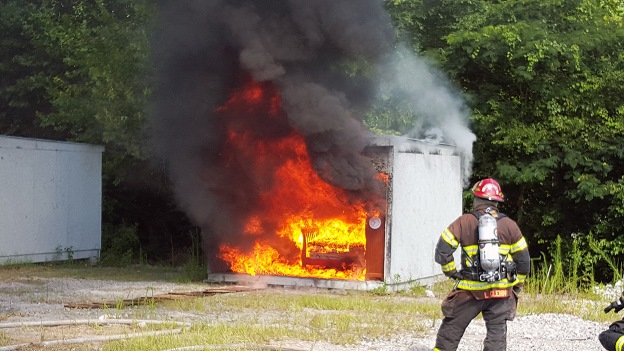CNS, University of Tennessee Partner on New Fire Protection Program
Fire is a significant threat to industrial facilities. To enhance our fire protection expertise, CNS has partnered with the University of Tennessee, Knoxville, on a new graduate-level engineering program.

The Graduate Certificate Program in Fire Protection Engineering gives our employees new educational and career opportunities while improving the CNS enterprise’s fire protection capabilities. Twenty five CNS employees from a cross-section of organizations are acquiring critical skills in fire protection engineering while earning graduate-level credit.
Y 12 Fire Protection Engineering Manager David Greer and UT Electrical Engineering and Computer Science professor David Icove got the program rolling. Greer contacted Icove in January 2014 about teaching a course on Fire Dynamics Simulator software to his staff. The two discussed the idea and determined a university program, comprising several core courses open to all engineering students, would better serve CNS and UT.
Fire protection engineering uses the fundamental principles of advanced science and engineering to protect people, property, and the environment from fire. The field is facing a shortage of qualified engineers, so the graduate certificate program makes specialized training available to CNS engineers from different disciplines, as well as UT students studying engineering and related fields.
“As a profession, fire protection engineering is in high demand, and there is a very short supply of qualified engineers. Currently, only two schools in the U.S. offer accredited engineering degrees — Oklahoma State University and the University of Maryland. UT is now the only university in the southeast offering accredited coursework in this field,” Greer said.
The UT Fire Protection Engineering program, which launched in fall 2014, offers four graduate-level courses. The courses combine industry perspective with university expertise, and class assignments are designed around real Pantex and Y 12 problems. Icove, an internationally recognized forensic engineering expert with more than 40 years of experience in the field, teaches the courses.
The initial 16 week program met with success, so this summer UT offered each of the four courses in condensed three week sessions. “This special compressed program is intense,” Greer said. “In a one week period, the students get a semester’s worth of time in class, plus two weeks for homework and a term paper. In three weeks, they’ll complete a graduate-level engineering course but will only be away from the plant for four days. The format is very demanding, but it is the only way many of the participants would ever have time available to take these courses.”
CNS Chief Fire Protection Engineer Randy Lanham said engineers at the Pantex Plant who have taken courses have been impressed. “One engineer said he can use the information in his job right now — which is a big positive. Another said taking the courses has encouraged her to continue with a master’s degree in fire protection engineering,” Lanham said.
Matthew Alt, a UT civil engineering graduate who now supports Uranium Processing Facility Quality Assurance, said the program is a great opportunity to obtain training in a different field.
“We perform a lot of oversight reviews, and these courses provide the tools and training for reviewing process and program documents like the Preliminary Fire Hazards Analysis.”
The curriculum offers CNS the opportunity to provide new educational and career opportunities to employees and to target qualified fire protection engineering candidates likely to establish careers locally. “We hope to see this develop into a full master’s program in the near future,” Greer said.
Greer is appreciative of the commitment and support he has received while working through the details of starting the program. “I had to work through the process, but every person, without exception, has been positive about the program. Not once did anyone say ‘no,’ ‘stop,’ or ‘slow down’ — it was always ‘Great idea! What can we do to help?‘” He credits Linda Bauer, Mike Beck, Tom Christman, and Debbie Reed for helping get the program launched.
